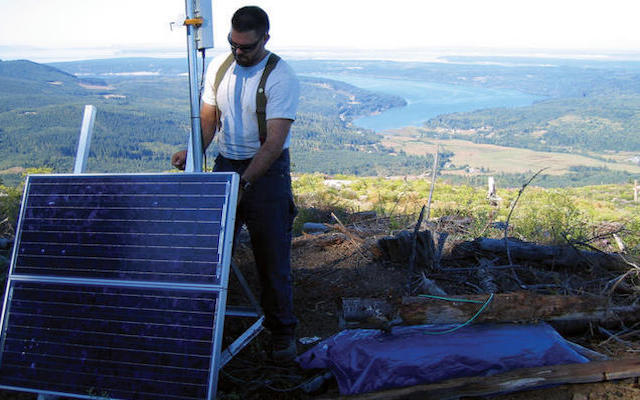Geophysics

EES-17 scientists study the Earth’s dynamics to support national security. Here, Seismoacoustics Team Member Joshua Carmichael installs equipment in Washington monitoring for slow slip events in the lengthy Cascadia subduction zone. Monitoring may support an earthquake early warning system on the locked, active zone.
Advanced computational physics of Earth’s crust materials
Geophysics (EES-17) supports national security by providing technical expertise in the geodynamics of Earth's crust.
We have extensive expertise in seismic and acoustic monitoring as well as numerical modeling of tectonic processes across a wide spectrum of scales from the near-field (explosive modeling) to the far-field (reservoir- and plate-scale stress fields).
In addition, we study the nonlinear properties of Earth materials, model the mechanics of rock fracture, and use seismology to evaluate the interaction of porous rocks and fluids.
Our science
- Applied seismology: evaluation of seismic wave generation and propagation; analysis of critically stressed faults; earthquake triggering; global seismic monitoring
- Elasticity, Vibrations, and Acoustics (EVA) Laboratory specializes in using acoustic and elastic waves for material characterization, material integrity and nondestructive evaluation, porous media characterization in high pressure fluid environments, full 3D waveform measurements using laser vibrometry, imaging and developing advanced ultrasonic techniques using time reversal and nonlinear elasticity
- Geologic framework model development
- Numerical modeling: high strain-rate shock propagation; multi-scale analysis of the crustal state of stress
- Seismic and acoustic imaging: inversion theory; seismic and acoustic tomography
- Comprehensive Test Ban Treaty support and training
- Earthquake triggering and earthquake processes
- Ground-based nuclear detonation detection
- Improved technologies to support sustainable energy (renewable, nuclear, and fossil fuel)
- Large-scale plate tectonic processes
- Seismic and medical imaging
- Nondestructive evaluation
- Numerical modeling of geodynamic processes
- Basic research associated with the non-linear elastic behavior of Earth and other materials
- Carbon sequestration risk assessment:
- National Risk Assessment Partnership (NRAP): prediction of carbon sequestration-induced seismicity
- State of stress: modeling to map from local to regional scale and monitor and assess risk
- Determining the Earth’s state of stress and the critical stress state preceding failure of faults
- Determining the effect of fluids on permeability in the crust
- Elasticity, Vibrations, and Acoustics (EVA) Laboratory projects
- Imaging non-linear elastic behavior in reservoirs
- Medical imaging
- Modeling to simulate and model propellant- and explosion-source fracture
- Nonlinear Elasticity and Material Team
- Nuclear nonproliferation support:
- Comprehensive Nuclear-Test-Ban Treaty support, field exercises
- Modeling to understand noble-gas seepage in fractured rock
- Multi-Phenomenology Explosion Monitoring (MultiPEM): nuclear treaty/explosion monitoring
- National security mission in containment: subcritical experiments to ensure containment of special nuclear material following experiments
- Nuclear seismo-acoustic nuclear detonation detection and wave propagation
- Seismic monitoring
- Source Physics Experiment (SPE) to improve low-yield nuclear explosions’ event identification
- Underground Nuclear Explosion Signatures Experiment (UNESE)






